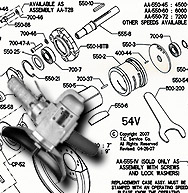
So it may not be much of an advantage over what I'm doing.
TOPCAT TOOL PC
However, I expect it would require a copy of TOPCAT's ProgramData or Appdata folders (wherever) on the PSU PC as well, as that is where TOPCAT would actually be run. Works very well - so PSU could probably do the same, using the Network path in its execution request.
TOPCAT TOOL INSTALL
I run Prosim737.EXE on a separate PC to FSX-SE, but to get Prosim's scenery database updated I run the one install on the Network from the FSX PC. Manages cost for rigs and equipment without compromising of safety. Some configuration setting and sharing some folders properly should be possible. Employment Tool pushers and crews directly report to rig supervisor. I guess PSU feeds enough information to allow the LoadSheet and TODC computations to match!īut it would indeed be better for PSU to be able to find TOPCAT properly even across a Network. The same TOPCAT figures seem to be produced. I have TOPCAT installed on two PCs - the one with PFPX (down in my office, the "dispatch" office) and on on the same PC as PSU in my cockpit room. Have anyone solved this? Am I missing something? Am I the only one that have PFPX on a tablet in cockpit?
TOPCAT TOOL SOFTWARE
Topcat is a discontinued software as i understand, and we will never get network functionality into that software.

We really need to find a solution where PFPX/TOPCAT can reside on networked PCs without PSU. Could it communicate to PSU via ACARS? It seems backwards. It kills the experience if I have to find mouse and keyboard again. I really do not want to place PFPX on my main PC, or any other PC controlled by keyboard and mouse on one of my screens in cockpit. I dont want to do my planning, or anything else, on the screens used for view. The tablet is much slower than my other computers and is having more than enough with running PFPX + Aivlasoft EFB already, and the Main PC run P3D on all 5 screens + some hidden services that don't need to be visible, like PSU, OpusFSI, vPilot, EFB DataProvider etc.

From vertical grinders, horizontal grinders, right. This force me to place psu on my tablet or place PFPX+Topcat on my Main PC (running P3D), and that is really not a ideal situation. Service Company employs modern technology and equipment to produce top quality Top Cat industrial air tools. Topcat have to reside in default folder on the same pc as pfpx for pfpx to know where it is Topcat HAVE! To reside on default directory on the pc PSU is installed on

pfpx need to send fp to topcat for calculations, and PSU will also need to contact Topcat to get wight data. I guess it come soon? All the data is there now. Pfpx is as I wrote, used IN cockpit during planing, and i also file my flightplan from pfpx as i cannot find a way to do it in psu still.
TOPCAT TOOL WINDOWS
I use pfpx on a windows tablet in cockpit during planning. To get proper weight and derated TO data into the FP, I bought Topcat yesterday, but i cannot place it where i want/need in my network due to the connection dependencies of PSU -> Topcat -> PFPX.

I have used pfpx for a few days now, and it is so cool to use this tool for planning and filing to VATSIM. These case studies highlight additional information gained through performing a detailed, discretized analysis using TopCAT.Starting to understand more and more functions of PSU, and bought Topcat to get even more use of psu. The results compare well (generally within 6%) with previous investigations. The second case investigates the alongshore volumetric beach sand change caused by hurricane Bonnie (1998) for an 85km section in the Cape Hatteras National Seashore, North Carolina. The first case examines coastal cliff retreat for a 500m section in Del Mar, California and shows that large failures comprised a large portion of the total eroded volume and the average retreat rate does not provide a good estimate of local maximum cliff retreat. To demonstrate the capabilities of TopCAT two case studies are presented herein. TopCAT was specifically designed for the morphological analysis of seacliffs and beaches but may be applied to other elongated features which experience topographical change, such as stream beds, river banks, coastal dunes, etc. This paper discusses the development of a new GIS extension named the Topographic Compartment Analysis Tool (TopCAT), which compares sequential digital elevation models (DEMs) and provides a quantitative and statistical analysis of the alongshore topographical change.


 0 kommentar(er)
0 kommentar(er)
